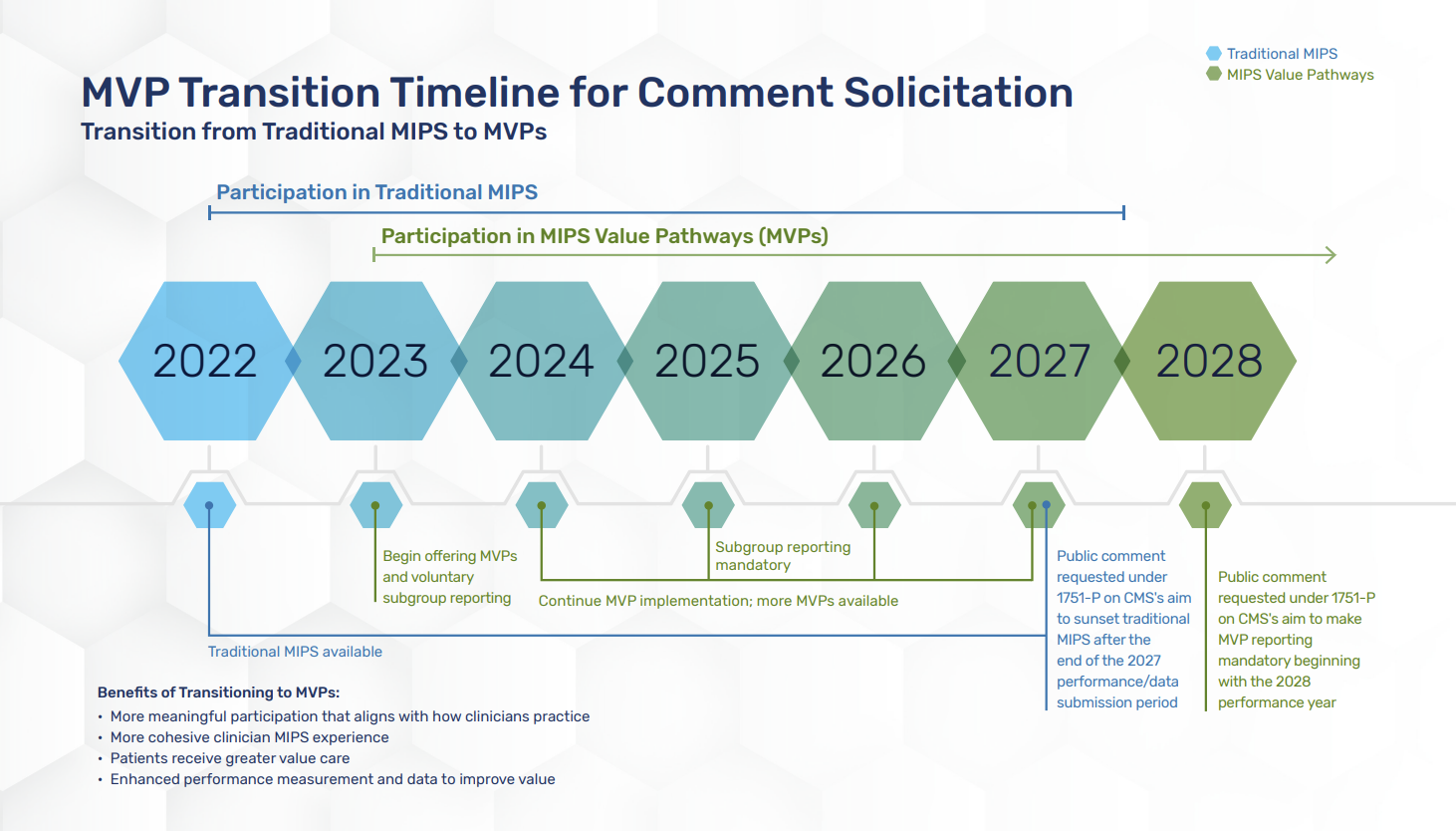MIPS Value Pathways (MVPs): The Future of Reporting Success
Posted by Janna Vienca Cañezal
The Centers for Medicare & Medicaid Services (CMS) launched the new MIPS Value Pathways (MVPs) program in its 2022 Physician Fee Schedule (PFS) Final Rule. MVPs include seven new pathways that eligible clinicians can voluntarily participate in starting in the 2023 MIPS performance year.
Since its launch in 2017, MIPS evolved into an overly complex program that resulted in siloed measure and activity reporting. MVPs aim to solve this problem and move toward a set of measures and activities that are more clinically related to each other and more relevant to a clinician's scope of practice. CMS projects that MVPs will make a more cohesive, more meaningful, and less burdensome reporting. Patients benefit from MVPs, too, as providers gear towards more specialized care relating to their medical condition.
What are MIPS Value Pathways (MVPs)?
MVPs are a subset of measures and activities relevant to a specialty, medical condition, or episode of care aimed to align and connect the four separate performance categories of MIPS. One of the structural flaws of traditional MIPS, the current framework, is that clinicians can select high-performance measures, even if the measures are not meaningful to their area of specialty. MVPs eliminate potential cherry-picking by having clinicians report on measures and activities relevant to their practice areas rather than selecting their top-performing one.
 Photo via Centers for Medicare & Medicaid Services (CMS).
Photo via Centers for Medicare & Medicaid Services (CMS).
CMS aims to create a core set of measures and activities that complement each other and drive meaningful improvements to patient care by targeting specialty care. The seven proposed pathways are:
- Rheumatology
- Stroke care and prevention
- Heart disease
- Chronic disease management
- Emergency medicine
- Lower extremity joint repair
- Anesthesia
The 2023 MVP guide by CMS provides details on what each pathway entails. CMS initially planned to sunset the traditional MIPS framework and make MVPs mandatory by 2028 but did not establish a final timeframe in the 2022 Final Rule. CMS also acknowledges that they need to develop more MVPs to cater to other specialties and medical conditions. Until then, clinicians can still report under the traditional MIPS framework.
The transition to MVPs starts the 2023 MIPS performance year to allow time for practices to review the requirements, update their workflows, and prepare their systems. MVP participants for the 2023 and 2024 MIPS performance years include individual clinicians, single-specialty groups, subgroups, multispecialty groups, and APM groups. By the 2025 MIPS performance year, CMS requires multispecialty groups to form subgroups to report under an MVP.
What is the MVP Registration Process?
.png?width=730&name=NEW!%20Meditab%20Blog%20Images%20(44).png)
MVP participants need to register between April 1 and November 30 of the performance year or a later date specified by CMS. During registration, MVPs participants need to select:
- The MVP they intend to report.
- One population health measure included in the MVP.
- Any outcomes-based administrative claims measure the MVP participant intends to be scored, if available within the MVP.
CMS requires clinicians reporting as a subgroup to:
- Identify the MVP the subgroup will report along with one population health measure included in the MVP and any outcomes-based administrative claims measure on which the subgroup intends to be scored, if available.
- Identify the clinicians in the subgroup by Taxpayer Identification Number (TIN) / National Provider Identifier (NPI).
- Provide a plain language name for the subgroup for purposes of public reporting.
MVP participants cannot change their registration after November 30 of the performance year and cannot report on an MVP they did not register.
What are the MVP Reporting Requirements?
Measures under the MVP layer categories will vary according to the clinician's chosen pathway. Still, they may report on the same set of foundational measures related to promoting interoperability (PI) and population health measures.
MVP Layer
- Quality Category
- The MVP participant selects four quality measures where one must be an outcome or a high priority measure.
- Improvement Activities Category
- The MVP participant selects two medium-weighted improvement activities OR one high-weighted improvement activity OR participation in a certified or recognized patient-centered medical home (PCMH), if available in the selected MVP.
- Cost Category
- CMS calculates performance based on submitted administrative claims data.
Foundational Layer
- Promoting Interoperability Category
- Clinicians will use the same PI measures under the traditional MIPS unless they qualify for reweighting or have an approved hardship exemption.
- Population Health Measures
- At the time of registration, participating clinicians select one population health measure where the results are added to the quality score.
How Can You Successfully Report for MVPs?
-1.png?width=730&name=NEW!%20Meditab%20Blog%20Images%20(44)-1.png)
The 2022 Physician Fee Schedule (PFS) Final Rule contains several changes, making 2022 MIPS reporting even more challenging. 2022 will be the year where the guidance of a MIPS expert is needed more than ever as we slowly make room for MVPs. 2023 may seem far away, but familiarizing yourself with the new reporting framework now helps give you a head start. By the time MVPs become mandatory, you'll have a hassle-free reporting year.
MVPs usher in a significant shift in the way practices report for MIPS. To help you get the most out of MVPs, Meditab has the tools and the team to prepare you for MVP reporting. Designed to be agile and flexible, our core EHR software, IMS, comes with MIPS reports and dashboards to help you track your MIPS scores for both traditional MIPS and MVPs. In addition, our dedicated QPP Team has years of MIPS experience and is always on top of any regulatory changes.
Talk to our MIPS experts, learn more about IMS, and enjoy a seamless transition to MVP reporting today.
Share this post: on Twitter on Facebook on Google+

.png)
